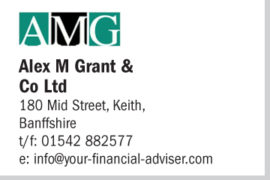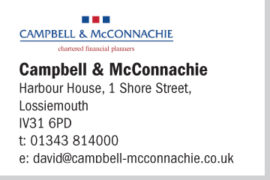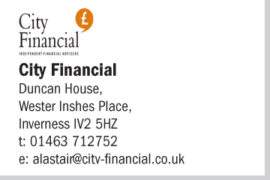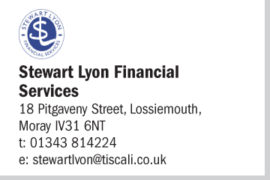INDEPENDENT FINANCIAL ADVICE ON MONEY MATTERS AROUND THE HIGHLANDS, ISLANDS & MORAY
No-one knows what’s around the corner.
So it makes sense to take a moment to consider how you and your family would manage if you were to die unexpectedly, have an accident or be diagnosed with a critical illness.
It’s estimated that each year one million people in the UK find themselves unable to work due to a serious illness or injury. However, the average number of days households in Scotland could survive financially on their savings is just 30 (L & G “Deadline to Breadline” 2020).
No matter what happens, there are still bills to pay, such as rent or mortgage, gas, electricity and groceries. Ideally we’d all have a “rainy day” fund to see us through such difficult times, but for many of us, this isn’t always achievable.
Not many employers support their staff for more than a year if they’re off sick from work. And the state benefit safety net increasingly won’t pay you enough to maintain your current lifestyle, with Statutory Sick Pay currently £96.35 for up to 28 weeks.
Protection insurance
Protection insurance is designed to cushion you and your family against the impact of such unexpected, traumatic and potentially costly events.
This can include lump sum payments to provide financial support following a bereavement or diagnosis of serious illness and monthly payments to replace lost income following ill health or injury.
Some insurers also offer rehabilitation services to help you return to work after your illness and may also provide a wide range of extra services, such as online medial consultations, counselling and bereavement support.
Life insurance
Life insurance is one of the most straightforward types of protection insurance. Quite simply, it pays out a lump sum when you die or are diagnosed with a terminal illness. You can choose the amount you want to be insured for and the period for which you want cover.
Level Term insurance
With Level Term insurance, your life cover stays the same throughout the term of the policy.
Decreasing Term insurance
With Decreasing Term insurance, cover reduces each month over the term of the policy. This type of insurance is useful if you want to cover a reducing debt such as a repayment mortgage. It is usually less expensive than level term assurance.
Family Income benefit
Rather than paying a lump sum, a Family income benefit policy gives your dependents regular monthly payments if you die, providing them with financial security at a difficult time. However, within a given timescale, you’re much more likely to develop a critical illness than to die.
Critical Illness policy
A Critical Illness policy pays out a tax-free cash lump sum if you’re diagnosed with one of a number of listed critical illnesses, including some types of cancer, a heart attack or stroke. You may want it to pay for medical treatment, cover adaptations to your home or to pay off your mortgage. But although a lump sum may ease financial pressures, it won’t produce an income to pay your day to day living expenses.
Income Protection policy
If you were unable to work due to illness, an Income Protection policy will pay you a monthly income to replace some of your lost earnings until you can start working again. Income protection not only protects you if a physical condition means you can’t work, but it may also pay out if you suffer from a mental health condition which prevents you from working.
In fact, mental health is one of the most common causes of claim on income protection policies in the UK, according to the Association of British Insurers. If you’re worried about the cost, remember that protection insurance can be very good value, often starting from just a few pence a day, particularly if you take it out when you’re young.
That could be less than the cost of a take-away – it’s up to you to decide what’s more important! A well put together protection plan considers not only big financial commitments like your mortgage, but also takes into account your monthly lifestyle costs.
An independent financial adviser will help you to work out what cover is right for you and how much of it you need. They will look at a wide variety of insurance providers to find the best policies for your individual needs.
Next month’s topic is on IHT / Other tax areas
Contact your local Independent Financial Advisers for a no obligation initial discussion – Click to visit their website:





